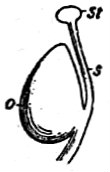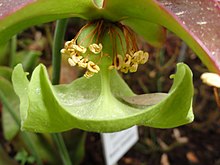Style (botany)

|

|
|
|
Stamp with stylus (g)
|
Multiple pen stamps by Linum
|



The stylus or stylus in a flower is the part of a carpel or pistil that bears the stigma . The term stilus originally means pen or stylus , it was already used by Clusius and has become generally accepted since Malpighi and Jungius .
A stylus can only occur as part of the carpel in coversamers . Even in the case of non-overgrown (apocarpic) carpels, the upper area of the carpel, which no longer contains any ovules , can be called a style. Usually the term stylus is only used for coenocarpic carpels. Depending on how far the carpels have grown together, there may be several styles. They can be partially fused and form free style branches at the upper end (“stylodia”), or they can be fused into a single style, at the end of which there are still as many scars as carpels, or there can also only be a uniform scar tissue be.
Stylodien , Stylodia are partially regarded as an extended scar, the stylus branches appear like; Wrong style (stylode), even with reduced pistil lodes with only the (reduced) style branches. Or even if each carpel has its own style.
The stylus is usually terminal when it is on the tip of the ovary , or on the side when it is next to or below the tip, as in the case of the mangoes ( Mangifera ), and basal when it is at the bottom of the ovary, here are the Carpel fused and the stylus is on the base of the flower , then this position is called gynobasic , as with the predatory plants . In the case of a few species, intermediate forms are possible; subend , base or end ; z. B. in some Ficus species, and subgynobasic as in leek ( Allium ).
Inside the stylus is the conducting or transmission tissue that extends from the scar down to the ovary. In this transmission tissue, the pollen tubes grow to the individual ovules. A distinction is usually made here between two types of stylus in which the transmission tissue is different; Usually solid with a ( compitum ), but also hollow , here there is a special channel (lumen) from the ovary to the scar. Some authors still distinguish a half-open fabric.
In some plants, including the umbelliferous plants and the genus Shorea , a stylopodium (stylus pad, foot, disc), a pillow-like, conical or disc-shaped thickening, a pedestal at the base of the stylus, which often produces disc- like nectar, forms is eliminated.
In some plant species, e.g. B. with the aster-like , the stylus, the mostly hermaphrodite and protandric flowers, can be equipped with special hairs (bearded, stylus brush), the hairs (collecting hairs, sweeping hairs) serve to catch the previously spread pollen of the anthers and thus take on the function of a secondary pollen presentation . However, recent studies also show that they are part of an efficient mechanism that controls the opening of the stigma and promotes cross- pollination . Touching stimulation of the hair shortens the male phase and accelerates scar maturation. The more often the hair is stimulated, the shorter the male phase. There can also be a stylus, pollen cup (or indusium), an outgrowth, a hem at the end of the stylus that encloses the stigma in a cup-shaped manner, as is the case with the Goodenia family . There can also be a spoon-shaped or hook-shaped outgrowth at the end of the stylus, on which pollen is deposited, as in the finial plants . These different pollen collection structures are called "pollen presenters".
In the case of a few species ( arrowroot family Marantaceae), the stylus can roll up irreversibly and explosively when it comes into contact with a pollinator, thus stripping pollen from the pollinator and transporting it into a special cavity and at the same time releasing its own pollen from the pollen plate , which was previously released from the stigma during flower development has been.
Flexistyly is also possible, which occurs in some species, depending on the degree of ripening of the stamens , the stylus moves up or down here, as in the real galangal . It is believed that this prevents pollination with its own pollen, i.e. self-pollination .
In some species ( Apocynaceae ) a so-called “clavuncula” is formed, here the style widens directly below the stigma. This is also known as the stylus or scar head.
The stylus usually falls off after fertilization, but it can also be permanent and then wither or grow.
See also
literature
- Peter Sitte , Elmar Weiler , Joachim W. Kadereit , Andreas Bresinsky , Christian Körner : Textbook of botany for universities . Founded by Eduard Strasburger . 35th edition. Spektrum Akademischer Verlag, Heidelberg 2002, ISBN 3-8274-1010-X , p. 764 f .
Individual evidence
- ^ Gerhard Wagenitz : Dictionary of Botany. The terms in their historical context . 2nd expanded edition. Spectrum Academic Publishing House, Heidelberg / Berlin 2003, ISBN 3-8274-1398-2 , p. 315 .
- ^ A b Hermann Hager : Botanical lessons in 160 lessons. 3rd edition, Springer, 1885, ISBN 978-3-642-89788-7 (reprint), p. 198.
- ^ Michael G. Simpson: Plant Systematics. Academic Press, 2006, ISBN 0-12-644460-9 , p. 378 f.
- ↑ Chittaranjan Kole: Wild Crop Relatives: Genomic and Breeding Resources. Springer, 2011, ISBN 978-3-642-20449-4 , p. 1.
- ↑ Rong Shu: Ficus. In: Flora of China. 5, 2003, pp. 37-71, online (PDF), at eFloras.org, accessed on May 18, 2018.
- ↑ KR Shivanna, Rajesh Tandon: Reproductive Ecology of Flowering Plants: A Manual. Springer, 2014, ISBN 978-81-322-2002-2 , p. 51 ff.
- ^ Focko Weberling : Morphology of Flowers and Inflorescences. Cambridge Univ. Press, 1989, ISBN 0-521-25134-6 , p. 192.
- ↑ Valayamghat Raghavan: Molecular Embryology of Flowering Plants. Cambridge Univ. Press, 1997, ISBN 0-521-55246-X , p. 192.
- ↑ Peter K. Endress: Diversity and Evolutionary Biology of Tropical Flowers. Cambridge Univ. Press, 1994, 1998, ISBN 0-521-42088-1 , pp. 53 f, 76 f, 204.
- ^ Veit M. Dörken: Campanulaceae - bluebell plants (Asterales). online (PDF), at cms.uni-konstanz.de, accessed on May 7, 2018.
- ^ Strasburger - Textbook of Plant Sciences. 37th edition, 2014, ISBN 978-3-642-54434-7 , p. 714, limited preview in Google Book Search.
- ^ A b P. G. Ladd: Pollen presenters in the flowering plants form. In: Botanical Journal of the Linnean Society. 115 (3), 1994, pp. 165-195, doi : 10.1006 / bojl.1994.1040 , online (PDF; 2.2 MB), from Oxford Academic - Oxford University Press, accessed on May 18, 2018.
- ^ Yvonne Nyman: The Pollen-Collecting Hairs of Campanula (Campanulaceae). II. Function and Adaptive Significance in Relation to Pollination. In: American Journal of Botany. Vol. 80, No. 12, 1993, pp. 1437-1443, doi : 10.2307 / 2445673 .
- ↑ Eug. Warming : Handbook of Systematic Botany. Bornträger, 1911, Salzwasser, 2012, ISBN 978-3-86444-713-6 , p. 473.
- ^ PF Yeo: Secondary Pollen Presentation: Form, Function and Evolution. Springer, 1993, 2012, ISBN 978-3-7091-7375-6 (reprint), pp. 140-150.
- ↑ Maria Thurner: Biology of the Marantaceae (arrowroot family) especially Calathea sp. Bachelor thesis, Univ. Vienna, 2003, online (PDF), at the University of Vienna, accessed on May 18, 2018.
- ↑ Alexandra C. Ley, Regine Claßen-Bockhoff: Floral synorganization and its influence on mechanical isolation and autogamy in Marantaceae. In: Botanical Journal of the Linnean Society. Volume 168, Issue 3, 2012, pp. 300–322, doi : 10.1111 / j.1095-8339.2011.01202.x .
- ↑ Stephan Endlicher , Franz Unger : Fundamentals of botany. Gerold, 1843, pp. 274-280.